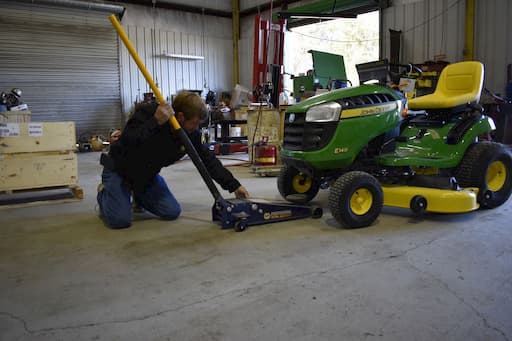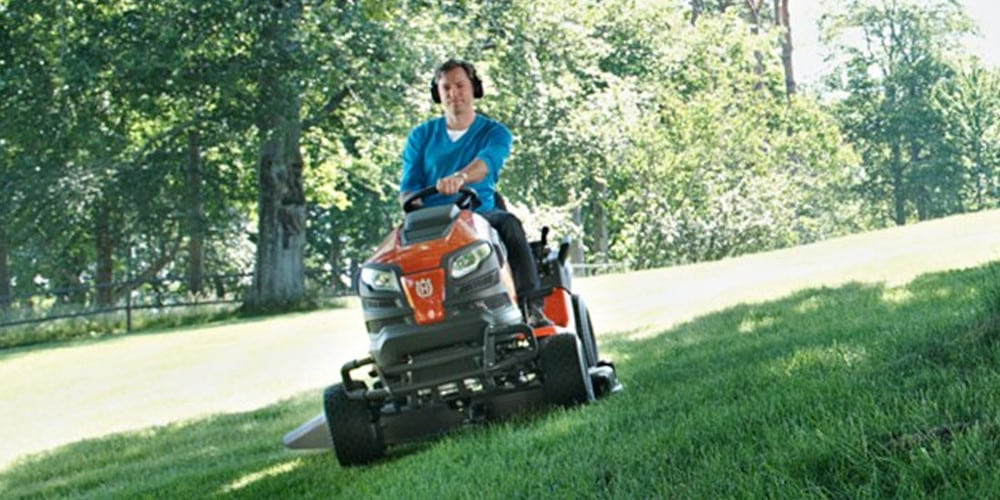To sharpen riding lawn mower blades, remove them from the mower and use a file or grinder. Make sure to maintain the blade’s balance for optimal performance.
Keeping your riding lawn mower blades sharp is essential for maintaining a healthy lawn. Sharp blades cut grass cleanly, promoting better growth and reducing the risk of disease. Dull blades, on the other hand, can tear grass, leading to an uneven and distressed lawn.
Frequent mowing calls for regular blade maintenance to ensure peak performance of your equipment. Homeowners and landscaping professionals alike must prioritize this task to keep their lawns looking their best. With the right tools and a bit of know-how, the sharpening process can be both straightforward and effective, providing a clean cut with every use of your riding lawn mower.

Credit: www.trigreenequipment.com
Sharpening Lawn Mower Blades Essentials
Maintaining a pristine lawn requires more than just regular mowing; attention to your mower’s blades is essential. This section explores the vitality of sharp blades, the dangers of neglect, and sharpening frequency for peak mower performance.
Importance Of Maintaining Sharp Blades
Sharp blades are the cornerstone of lawn care. They ensure clean, healthy cuts that promote grass growth and safeguard against disease. Dull blades tear grass, creating ragged edges that are susceptible to pests and decay. Regular sharpening extends blade life, saves fuel by reducing mower workload, and ensures a uniformly manicured lawn.
The Risks Of Cutting With Dull Blades
Utilizing dull blades risk plant health and mower integrity. Torn and bruised grass becomes a hotbed for diseases and reduces curb appeal with an uneven cut. Moreover, it causes the mower to exert excessive force, leading to increased wear and potential engine failure.
Frequency Of Sharpening For Optimal Performance
Sharpening frequency depends on blade usage and lawn size. A good rule of thumb: sharpen after 20-25 hours of use, or at least once per mowing season. Keeping an extra set of blades handy ensures no downtime in lawn maintenance.
- Inspect blades after each use for wear and tear.
- Monitor mower performance; difficulty in cutting or uneven patterns may indicate dull blades.
- Schedule regular maintenance; incorporate sharpening as part of your lawn care routine.
Preparing To Sharpen Your Blades
Sharp blades are essential for the performance and safety of your riding lawn mower. Dull blades rip and tear the grass, leading to an uneven cut and possibly exposing your lawn to diseases. Preparing adequately for the sharpening procedure ensures a smooth and safe maintenance experience. This guide will lead you through important safety measures and the tools and materials you will need to hone your mower’s blades to perfection.
Safety Measures And Precautions
When handling mower blades, safety comes first. It’s paramount to take the correct safety measures to prevent accidents. Follow these steps to safeguard your wellbeing:
- Disconnect the spark plug wire to prevent accidental starting.
- Wear protective gloves to guard against cuts from sharp edges.
- Use safety glasses to shield your eyes from metal filings and debris.
- Ensure the mower is on a stable flat surface before working on the blades.
- Engage the parking brake of the mower to keep it from rolling.
Tools And Materials Needed For The Job
Having the right tools and materials on hand is critical for a successful sharpening process. Gather these items before beginning:
| Tool/Material | Purpose | Notes |
|---|---|---|
| Gloves | Protect hands | Heavy-duty gloves recommended |
| Safety Glasses | Eye protection | Clear or tinted based on preference |
| Socket Wrench | Blade removal | Size may vary based on mower model |
| Bench Vise or Clamps | Secure blade | Adjustable to fit varying blade sizes |
| Metal File or Bench Grinder | Sharpening the blade | Choose based on comfort and experience |
| Blade Balancer | Ensuring balance | Critical for proper mower operation |
| Clean Cloth | Cleaning blades | For removing debris and grease |
With the mower prepped and the necessary tools at your disposal, you’re ready to proceed with confidence knowing you’re fully prepared to sharpen the blades of your riding lawn mower.
Steps To Sharpen Riding Lawn Mower Blades
Keeping your riding lawn mower blades sharp is essential for the health of your lawn and the efficiency of your equipment. Dull blades can tear grass, resulting in a ragged cut and stressing the grass. Sharpening your mower blades ensures a clean cut and a healthier lawn. Let’s take a look at the steps required to keep your blades in top-notch condition.
Removing The Blades Safely From The Mower
- Disconnect the spark plug wire to prevent accidental starts.
- Use protective gloves and block the blade with a piece of wood to prevent it from turning while you remove the bolts.
- Unscrew the bolts and carefully remove the blade.
Techniques For Assessing Blade Condition
- Examine the blade for signs of excessive wear or damage such as bends, cracks, or large chips.
- Look for worn down cutting edges. A blade should be replaced if the damage is too extensive for sharpening.
- Determine if the blade is a candidate for sharpening or if it should be replaced entirely.
Cleaning The Blades Before Sharpening
Before you proceed to sharpen the blades, it’s crucial to clean them thoroughly. This ensures the removal of any gunk or buildup that can affect the sharpening process.
- Brush off loose grass and debris with a stiff brush.
- Apply a degreaser if necessary to remove oil and sap.
- Rinse the blade with water and dry it properly to avoid rusting.
Achieving The Perfect Edge: A Quick Guide
Maintaining a sharp blade on your riding lawn mower ensures a cleaner cut, healthier grass, and a more efficient mowing experience. Dull blades can tear grass, leading to a ragged lawn that’s susceptible to disease. Finding the ideal edge requires the right tools and technique. This quick guide will outline various methods to keep your mower slicing seamlessly through your grass.
The perfect edge can be achieved through several methods depending on your preference and the tools at your disposal. It’s essential to prioritize safety and effectiveness.
- Hand filing – Traditional yet effective; provides precision.
- Bench grinding – Fast and requires less manual effort.
- Drill-powered blade sharpeners – A middle ground between hand filing and machine grinding.
Step-by-step Guide To Hand Filing
Hand filing might be labor-intensive, but it offers a level of control that power tools cannot match. Following these steps will ensure a sharp edge every time:
- Remove the blade safely from the mower.
- Secure the blade in a vise.
- Clean off any debris or rust with a wire brush.
- Mark the cutting edge with a marker to track your progress.
- Use a hand file, following the original bevel angle, push with moderate pressure along the cutting edge in one direction.
- Inspect the edge and repeat the process as needed until sharp.
- Balance the blade to prevent mower vibration.
- Reinstall the blade onto your mower.
Using A Bench Grinder For Quicker Results
For those looking for speed, a bench grinder can sharpen mower blades rapidly. Follow these quick steps for swift and effective sharpening:
- Detach the mower blade and clean it thoroughly.
- Equip safety goggles and gloves.
- Turn on the bench grinder.
- Hold the blade at the correct angle to the grinding wheel.
- Move the blade back and forth against the wheel until sharp.
- Cool the blade if it overheats to maintain its temper.
- Balance the blade meticulously before reattaching it.
- Reattach the blade to your lawnmower ensuring it’s secure.
Regardless of the method you choose, maintaining the edge on your mower’s blades is vital for a beautiful and healthy lawn. Always follow the manufacturer’s safety guidelines and wear appropriate protective gear when sharpening blades.
Ensuring Proper Blade Installation
Before diving into the meticulous task of sharpening your riding lawn mower blades, it’s crucial to address blade installation. Proper installation is the foundation of mower maintenance and ensures a clean cut and safe operation. Neglect this step, and you’re at risk of an uneven lawn or worse, a dangerous situation. To guarantee peak performance after sharpening, follow these guidelines.
Techniques for balancing the bladesTechniques For Balancing The Blades
A balanced blade is essential for a vibration-free cut and the longevity of your mower. Here’s how to ensure your blades are well balanced:
- Start by cleaning the blade thoroughly to remove built-up grass clippings and debris.
- Use a blade balancer, which can be a cone-shaped tool or a wall-mounted magnet, to check the equilibrium.
- Hang the blade horizontally on the balancer. If one side dips, remove material from that side until it sits level.
The goal is to maintain the blade’s original shape and angle. Keep the adjustments minimal, ensuring equal weight distribution for a smooth operation.
Reattaching blades and ensuring a secure fitReattaching Blades And Ensuring A Secure Fit
Once your blades are sharp and balanced, reattach them carefully:
- Place the blade onto the mandrel, lining up any holes or notches accurately.
- Secure the blade with the bolts or fasteners provided, tightening them to the manufacturer’s specified torque.
- It’s imperative to double-check tightness after a few hours of operation to prevent any hazardous blade detachments.
Post-sharpening Mower Testing For Safety
It’s not just about having a keen edge; post-sharpening testing is equally crucial for safety. Perform these simple checks before mowing:
- Listen for unusual vibrations or noises which could indicate an unbalanced blade.
- Inspect the deck for proper blade clearance.
- Engage the cutting mechanism briefly at a low speed to ensure there are no issues.
These tests help catch any potential problems that could result in damage to your lawn mower or injury.
Frequently Asked Questions Of How To Sharpen Riding Lawn Mower Blades
Can You Sharpen Blades On A Riding Lawn Mower Without Taking Them Off?
Yes, you can sharpen the blades of a riding lawn mower without removing them by using a portable grinder or file, but proceed with caution. Always ensure your safety by disconnecting the spark plug before starting.
Do New Riding Mower Blades Need To Be Sharpened?
New riding mower blades typically come pre-sharpened and do not require immediate sharpening before their first use. Regular maintenance will ensure ongoing sharpness and optimal cutting performance.
How Often Should You Sharpen Ride On Mower Blades?
Sharpen ride-on mower blades every 20-25 hours of use for optimal cutting performance. Regular checks for damage also ensure blade maintenance.
Do You Sharpen Mower Blades To A Point?
No, you should not sharpen mower blades to a point; they should have a blunt edge for safety and effectiveness. Keep the angle around 30-45 degrees for optimal performance.
Conclusion
Keeping your riding lawn mower blades sharp ensures a clean, healthy cut for your lawn. By using the steps outlined, you can maintain peak blade performance and extend the lifespan of your equipment. Remember, regular maintenance is key for optimum mowing results and the enduring beauty of your grass.
Stay sharp and mow on!

